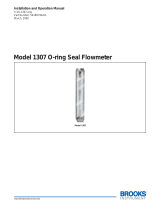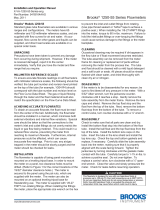Page is loading ...

The Series VFC Visi-Float
®
flowmeters are available in
two basic styles, either back or end connected with direct
reading scales for air or water. Installation, operation, and
maintenance are simple and require only a few common
sense precautions to assure long, accurate, trouble-free
service.
CALIBRATION
All flowmeters are calibrated at the factory and normally will
remain within their accuracy tolerance for the life of the
device. If at any time you wish to re-check its calibration, do
so only with instruments or equipment of certified accuracy.
Do not attempt to check the Visi-Float
®
flowmeter with a
similar flowmeter as even minor variations in piping and
back pressure can cause significant differences between
the indicated and actual readings. If in doubt, your flowme-
ter may be returned to the factory and checked for confor-
mance at no charge.
LOCATION
Select a location where the flowmeter can be easily read
and where the temperature will not exceed 120°F (49°C).
The mounting surface and piping to the flowmeter should be
free from vibration which could cause fatigue of fittings or
mounting inserts. Piping must be carefully arranged and
installed to avoid placing stress on fittings and/or flowmeter
body. Avoid locations or applications with strong chlorine
atmospheres or solvents such as benzene, acetone, carbon
tetrachloride,etc. Damage due to contact with incompatible
gases or liquids is not covered by warranty. Compatibility
should be carefully determined before placing in service.
PIPING
Inlet Piping:
It is good practice to approach the flowmeter inlet with as few
elbows, restrictions and size changes as possible. Inlet piping
should be as close to the flowmeter connection size as practical
to avoid turbulence which can occur with drastic size changes.
The length of inlet piping has little effect on normal pressure fed
flowmeters.
For vacuum service, the inlet piping should be as short and open
as possible to allow operation at or near atmospheric pressure and
maintain the accuracy of the device. Note that for vacuum service,
any flow control valve used must be installed on the discharge side
of the flowmeter.
VFC Series Visi-Float
®
Flowmeter
Specifications - Installation and Operating Instructions
Bulletin F-48
SPECIFICATIONS
Service: Compatible gases & liquids.
Wetted Materials:
Body: Acrylic plastic.
O-Ring: Buna-N (Flouroelastomer available).
Metal Parts: Stainless steel.
Float: Stainless steel.
Temperature & Pressure Limits: 100 psig (6.9 bar) @
120°F (48°C).
Accuracy: 2% of full scale.
Process Connection: VFC: 1˝ female NPT back connec-
tions. End connections optional. VFCII: 1˝ male NPT back
connections. End Connections optional.
Scale Length: 5˝ typical length.
Mounting Orientation: Mount in vertical position.
Weight: 24-25 oz (.68-.71 kg).
Back Connections
DWYER INSTRUMENTS, INC.
P.O. BOX 373 • MICHIGAN CITY, IN 46361 U.S.A.
Phone: 219/879-8000 www.dwyer-inst.com
Fax: 219/872-9057 e-mail: info@dwyer-inst.com
1-1/2
[38.10]
3
[76.20]
4-1/2
[114.30]
10-1/2
[266.70]
1-1/2
[38.10]
8-1/2
[215.90]
2 NOM
[50.80]
1-1/32
[26.19]
1-1/8
[28.58]
1-1/8
[28.58]
1-1/2 HEX
[38.10]
1-3/4
[44.45]
1-1/2
[38.10]
11
[279.40]
WITH
BACK
CONNECTIONS
F-48 1002:F-48 1002 7/24/09 9:19 AM Page 1

Discharge Piping
Piping on the discharge side should be at least as large as the
flowmeter connection. For pressure fed flowmeters on air or gas
service, the piping should be as short and open as possible. This
allows operation at or near atmospheric pressure and assures the
accuracy of the device. This is less important on water or liquid
flowmeters since the flowing medium is generally incompressible
and back pressure will not affect the calibration of the instrument.
POSITION AND MOUNTING
All Visi-Float
®
flowmeters must be installed in a vertical position
with the inlet connection at the bottom and outlet at the top.
Surface Mounting
Drill three holes in panel using dimensions shown in drawing. Holes
should be large enough to accommodate #10 - 32 machine
screws. If back connected model, drill two additional holes for
clearance of fittings. Install mounting screws of appropriate length
from rear. Mounting screws must not be longer than the panel
thickness plus
3
/
8
˝ (9.66 mm), or the screw will hit the plastic and
may damage the meter. The screws will require additional force
during the initial installation, since the insert boots are of a col-
lapsed thread type and must be expanded into the plastic for the
knurled surface to take hold. Insert boots will not have the proper
10-32 threads until the first screw has been inserted to expand the
boot. Use pipe thread sealant tape or pipe thread sealant to insure
against leakage.
CAUTION: Do not overtighten fittings or piping into fittings.
Maximum recommended torque is 10 ft. (lbs) (13.56 newton
(meter)). Hand tighten only.
In Line Mounting
Both end connected and back connected models may be installed
in-line supported only by the piping. Be sure that flowmeter is in a
vertical position and that piping does not create excess stress or
loading on the flowmeter fittings.
OPERATION
Once all connections are complete, introduce flow as slowly as
possible to avoid possible damage. With liquids, make sure all air
has been purged before taking readings. Once the float has stabi-
lized, read flow rate by sighting across the largest diameter of the
float to the scale graduations on the face of the device.
The standard technique for reading a Variable Area Flowmeter is to
locate the highest point of greatest diameter on the float, and then
align that with the theoretical center of the scale graduation. In the
event that the float is not aligned with a grad, an extrapolation of
the float location must be made by the operator as to its location
between the two closest grads. The following are some sample
floats shown with reference to the proper location to read the float.
Variable Area Flowmeters used for gases are typically labeled with
the prefix “S” or “N”, which represents “Standard” for English units
or “Normal” for metric units. Use of this prefix designates that the
flowmeter is calibrated to operate at a specific set of conditions,
and deviation from those standard conditions will require correc-
tion for the calibration to be valid. In practice, the reading taken
from the flowmeter scale must be corrected back to standard con-
ditions to be used with the scale units. The correct location to
measure the actual pressure and temperature is at the exit of the
flowmeter, except under vacuum applications where they should
be measured at the flowmeter inlet. The equation to correct for
nonstandard operating conditions is as follows:
Q
2
= Q
1
x P
1
x T
2
P
2
x T
1
Where: Q
1
= Actual or Observed Flowmeter Reading
Q
2
= Standard Flow Corrected for Pressure and
Temperature
P
1
= Actual Pressure (14.7 psia + Gage Pressure)
P
2
= Standard Pressure (14.7 psia, which is 0 psig)
T
1
= Actual Temperature (460 R + Temp °F)
T
2
= Standard Temperature (530 R, which is 70°F)
Example: A flowmeter with a scale of 10-100 SCFH Air. The float
is sitting at the 60 grad on the flowmeter scale. Actual Pressure is
measured at the exit of the meter as 5 psig. Actual Temperature is
measured at the exit of the meter as 85°F.
Q
2
= 60.0 x (14.7 + 5) x 530
14.7 x (460 + 85)
Q
2
= 68.5 SCFH Air
MAINTENANCE
The only maintenance normally required is occasional cleaning to
assure proper operation and good float visibility.
Disassembly
The flowmeter can be completely disassembled by removing the
connection fittings and top plug. When lifting out the float guide
assembly, be careful not to lose the short pieces of plastic tubing
on each end of the guide rod which serve as float stops.
Cleaning
The flowmeter body and all other parts can be cleaned by wash-
ing in a mild soap and water solution. A soft bristle bottle brush will
simplify cleaning of the flow tube. Avoid benzene, acetone, carbon
tetrachloride, gasoline, alkaline detergents, caustic soda, liquid
soaps, (which may contain chlorinated solvents), etc., and avoid
prolonged immersion.
Re-assembly
Install the lower fitting and then the float and float guide. Finally
install the upper fitting and plug being certain that both ends of the
float guide are properly engaged and the float is correctly oriented.
A light coating of silicone stop cock grease or petroleum jelly on
the “O” rings will help maintain a good seal as well as ease assem-
bly.
ADDITIONAL INFORMATION
For additional flowmeter application information, conversion
curves, correction factors and other data covering the entire line of
flowmeters, please request a Dwyer Instruments, Inc. full-line cat-
alog.
Bulletin F-48
©Copyright 2009 Dwyer Instruments, Inc.
Printed in U.S.A. 7/09
FR# 51-440448-00 Rev. 4
DWYER INSTRUMENTS, INC.
P.O. BOX 373 • MICHIGAN CITY, IN 46361 U.S.A.
Phone: 219/879-8000 www.dwyer-inst.com
Fax: 219/872-9057 e-mail: info@dwyer-inst.com
F-48 1002:F-48 1002 7/24/09 9:19 AM Page 2
/





